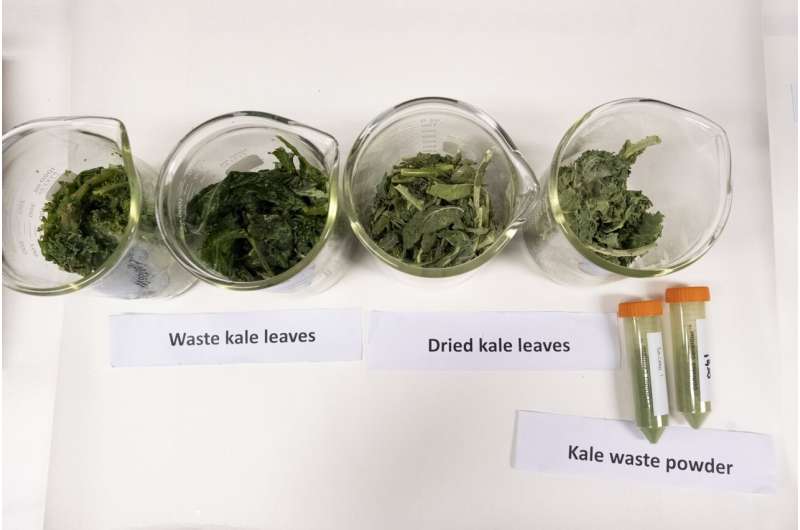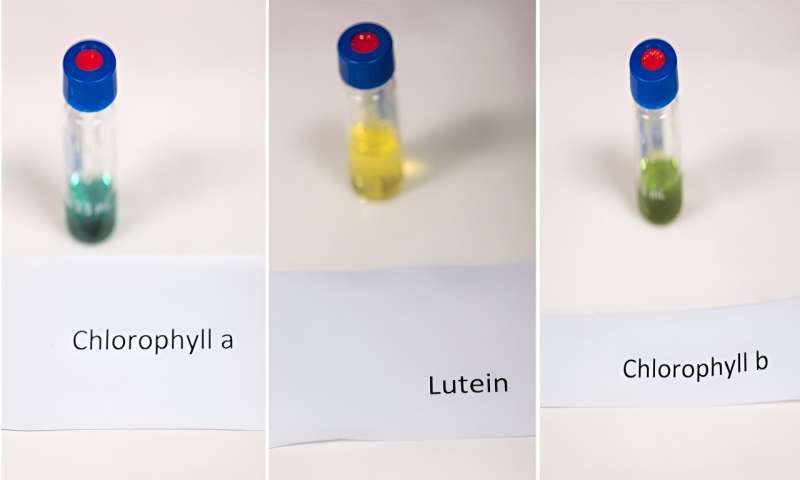This article has been reviewed according to Science X's editorial process and policies. Editors have highlighted the following attributes while ensuring the content's credibility:
fact-checked
trusted source
proofread
Scientists develop a sustainable way to convert kale waste into products for health and personal care

Scientists from Nanyang Technological University, Singapore have developed a new technique to convert kale waste for use in health and personal care products, reducing food waste and emissions.
Millions of tons of food and vegetables are discarded globally every year. In the case of leafy vegetables like kale and lettuce, farmers cut off outer leaves as they are harvested, in order to sell perfectly sized and aesthetically pleasing vegetables with no signs of damage or yellowing. This commercial practice results in a significant amount of perfectly good, edible leaves being thrown away.
In Singapore, some 817,000 tons of food waste were generated in 2021, almost half of which was fruit and vegetables.
Phytochemicals found in plants are known to prevent damage to cells in the body and are widely used in consumer products. They include health-promoting supplements, like antioxidants and lutein, as well as face scrubs and hair shampoo with kale extracts.
Current processes for extracting phytochemicals from kale are energy-intensive, requiring high pressure and temperatures, which contribute additional CO2 emissions to the environment. Moreover, the industrial extraction processes only target a single type of phytochemical each time.
Seeking a more sustainable and efficient method to turn vegetable waste into "treasure," the NTU researchers looked to naturally-derived natural deep eutectic solvents (NADES)—non-toxic liquids made up of plant-based compounds such as amino acid, sugar, and vegetable oil by-product—for answers.
While NADES have long been studied in separation technology for food and pharmaceutical industries, not much is known about their ability to extract different classes of bioactive compounds from vegetable waste.
Focusing on bioactive compounds in kale, the NTU research team explored a range of NADES, mixing them with processed kale waste to observe how molecules reacted to each other.
After repeated testing, the researchers established the best NADES solvent for optimal extraction of bioactive compounds. The NTU team found that when the kale waste and NADES mixture is stirred and set aside, it naturally separated into layers, facilitating the easy extraction of the phytochemicals from kale (polyphenols, carotenoids, and chlorophylls) without the need for heating.
Since there is no need to heat or pre-treat the kale waste, for example by freeze drying, the costs of the simpler extraction process are kept down. The NTU research team is confident their newly developed method would be scalable and attractive cost wise to the industry.
Lead author of the study, Professor Hu Xiao from the NTU School of Materials Science and Engineering (MSE) and Program Director, Sustainable Chemistry & Materials, Nanyang Environment & Water Research Institute (NEWRI), said, "The use of non-toxic and naturally derived solvents in our method makes it a food-safe technique. At the same time, our method preserves the potency of the extracted active ingredients, making it highly attractive for industry adoption. The extracted nutrients can potentially be used for applications in personal care products, cosmetics, food supplements, and herbal extracts."

The NTU research team said that their waste-to-resource approach tackles both food waste and reduces emissions, supporting the development of a circular economy with zero waste as outlined in the United Nations Paris Agreement.
The study, which was published in the journal Separation and Purification Technology in July, is aligned with the research pillar of NTU 2025, the University's five-year strategic plan which aims to leverage innovative research to mitigate human impact on the environment.
A non-toxic, high yield technique
Established industrial methods to extract beneficial compounds from plants involve the use of harmful chemicals like methanol, which can pose significant health and safety risks. In contrast, the NTU research team approach uses naturally derived NADES which are non-toxic.
The newly developed process involves first blending the kale waste into a paste (or freeze-dried and ground into a powder form). The researchers then mixed the kale paste (or powder) with their specially formulated NADES solvent and stirred it mechanically at room temperature, before filtering the mixture to extract the beneficial compounds. The entire low energy process, unlike current industrial methods that require high heat, is also fast and can be completed within 30 minutes.
Since bioactive nutritional compounds are temperature-sensitive and degrade with heating, the NTU method helps to avoid degradation, said the researchers.
In lab experiments, the team found that their approach successfully yielded an extract that was 2.2 times richer in polyphenols, compared to conventional methods using methanol. Moreover, the bioactive phytochemicals remained 'active' after storage at four degrees Celsius for 30 days, displaying excellent shelf-life.
First author Dr. Lee Sze Ying, a research fellow at the Environmental Chemistry and Materials Center at NEWRI at the time of the study, said, "Our extraction approach is unique because it allows for the simultaneous recovery and separation of multiple valuable compounds from the vegetable waste in a single process without using heat. Moreover, the polyphenol-rich extract remained stable in the extraction solvent, meaning that manufacturers can simply add the extract directly into the formula of their cosmetic products without further processing, reducing production time."
Co-author Dr. Liang Yen Nan, Senior Research Fellow, Environmental Chemistry and Materials Center at NEWRI, explained, "Our method essentially manipulates the chemical nature of NADES and other green solvents to maximize the extraction efficiency of the bioactive compounds found in kale."
"This approach induces simultaneous recovery of multiple phytochemicals from the kale and can easily be adapted for use in other types of vegetable and fruit wastes. Moreover, we have demonstrated that our approach remains viable even if we were to eliminate the energy-intensive freeze-drying of the kale waste, making our technology greener, cheaper, and scalable for industry use."
The team has filed a patent in Singapore for the innovation. For their next steps, the researchers are investigating the feasibility of applying their newly developed method to extract beneficial compounds from other types of fruits and vegetables, and medicinal plants like dragon fruit, spinach, and lettuce.
More information: Sze Ying Lee et al, Single-step extraction of bioactive compounds from cruciferous vegetable (kale) waste using natural deep eutectic solvents, Separation and Purification Technology (2023). DOI: 10.1016/j.seppur.2023.123677
Provided by Nanyang Technological University





















